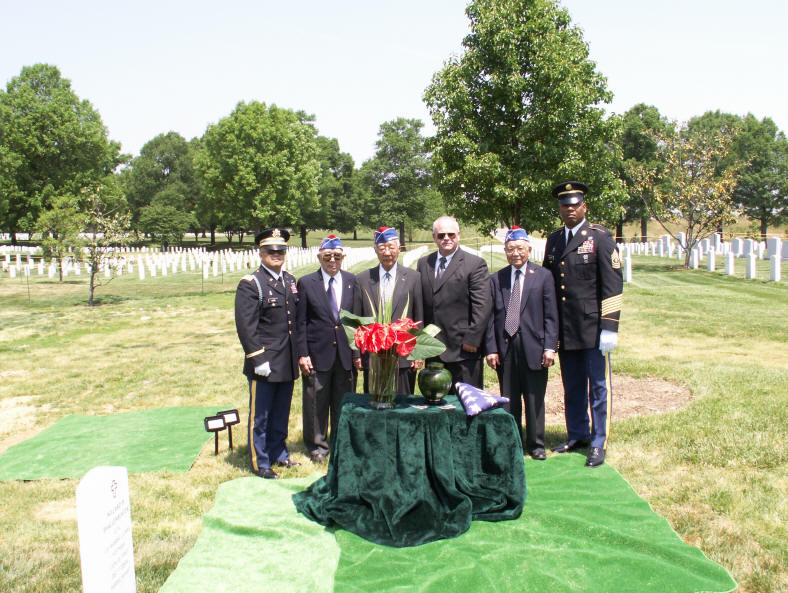JAPANESE AMERICAN
VETERANS ASSOCIATION
1666 K Street,NW, Suite 500,
Washington,D.C. 20006, c/o Gerald Yamada, Esq.
IMMEDIATE RELEASE:
Vol. II
May 21,
2007 No. 36
CONTACT:
Terry
Shima (301-987-6746; ttshima@worldnet.att.net
FOR PHOTO:
Go to JAVA website,
www.javadc.org, see press release. Picture embedded in press release in
title below.
- - - - - - - - - - - - - - - - - - - - - - - - - - - - - -
- - - - - - - - - - - - - - - - - - - - - - - - - - - - - - - -
MARTY HIGGINS BURIED AT ARLINGTON CEMETERY WITH FULL
MILIARY HONORS
Japanese American Veterans Association
Washington, D.C. Captain Martin Joseph
Higgins, 90, and his wife, Marjorie, who died on October 1, 1997, were buried at
the Arlington National Cemetery on May 15, 2007 with full military honors.
Higgins passed away on February 26, 2007. Three veterans of the 442nd
Regimental Combat Team representing the Japanese American Veterans Association
and two representatives of the 36th Division participated in the
funeral program. The 442nd Veterans Club Hawaii sent a box of red
anthuriums which were displayed at the chapel and at the gravesite. The 442nd
representatives were Joe Ichiuji, Kelly Kuwayama and Terry Shima. The 36th
Division representatives were CPT Edgardo Limbo, USANG, and 1SG John F. Sampa,
TXARNG.

L-R: Higgins gravesite at Arlington National Cemetery.
CPT Edgardo Limbo, USANG, Joe.Ichiuji, Kelly Kuwayama, Michael
Higgins; Terry Shima; 1SG John F. Sampa, TXARNG. Limbo and Sampa represented
the 36th Division. Ichiuji, Kuwayama and
Shima represented the Japanese American Veterans Association. Photo by CPT
Limbo.
Higgins’ contact with Japanese Americans began
on a fateful day, October 31, 1944, when elements of the 1st
Battalion, 141st Regiment of the 36th (Texas) Division,
were rescued by the 442nd Regimental Combat Team (RCT), a segregated
Japanese American unit, which included the 100th Infantry Battalion.
Higgins was selected by his peers to command 278 men, who had been encircled by
German forces in the Vosges forests of eastern France and was being
annihilated. After both the 2nd and 3rd Battalions of the
141st regiment failed to break through the enemy’s iron circle, the 442nd
RCT was assigned the tough job. The 442nd pierced the German
stranglehold after fighting for five days and nights and sustaining casualties
two to three times the number of the 211 soldiers left to be saved in the
141st. This rescue operation was subsequently characterized by the US Army as
one of the ten most fiercely fought battles in US Army history.
From that day onward, Higgins was a steadfast
friend of his Nisei rescuers speaking on their behalf at every opportunity to
contribute to the breakdown of prejudice and discrimination. He also supported
the passage of legislation which provided citizenship for the Issei, the first
generation Japanese residents in the US.. He was invited to various Nisei
veterans reunions, where he paid his respects to the rescuers both living and
the fallen. He used his personal funds to visit schools to educate them on
nationalism and the bravery of the Nisei.
Full military funeral for Higgins contained the
following elements: service at the Fort Meyer chapel, a
horse drawn caisson, caparisoned (rider-less) horse, a color guard, an
escort platoon., a military band, a military chaplain, three rifle volleys by
seven soldiers, military bugler, the formal folding of the flag, and the
presentation of the flag to a member of the family. 30